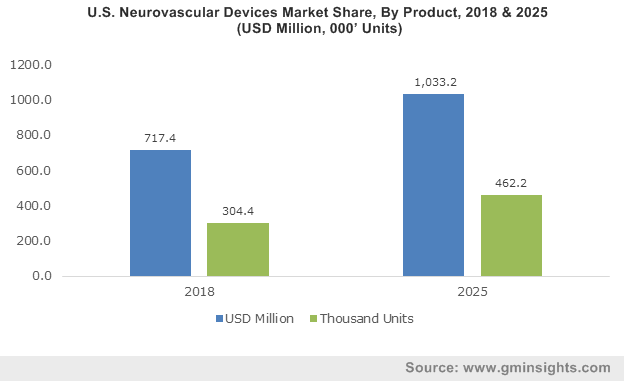Liquid Embolic Coils
Embolic coils based neurovascular devices market to accrue significant profits by 2025
Cerenovus, a renowned name in the global neurovascular devices market and a subsidiary of the Johnson & Johnson Medical Devices Companies, recently made it to the headlines for receiving a 510(k) clearance from the U.S. Food & Drug Administration for its EMBOTRAP II Revascularization Device. Sources reveal that the new device is a next-generation stent retriever that will be used to remove life-threatening blood clots from the brain after an ischemic stroke. Cerenovus’ recent FDA clearance thus, has brought a slew of benefits for the healthcare industry in terms of advanced devices and techniques helping physicians to better assist complicated surgeries.
U.S. Neurovascular Devices Market Share, By Product, 2018 & 2025 (USD Million, 000’ Units)

According to reports, the EMBOTRAP II Device is designed to rapidly restore blood flow by gripping & retrieving clots within the neurovasculature, thereby protecting against further complications. The FDA approval has indeed, quite overtly, helped the company strengthen its position in the global neurovascular devices market and drive the industry trends.
The rising incidences of stroke and intracranial aneurysm have undoubtedly played a major role in uplifting the product landscape of the neurovascular devices market. According to reliable sources, stroke affects about 800,000 Americans every year, and is a leading cause of disability in the continent, listed as the fifth leading cause of death. The statistics clearly validate that strokes which lead to poor blood flow to the brain are increasing at an exponential rate in the recent years.
Strokes have been found to be successfully addressed by endovascular surgical techniques, which by extension will fuel neurovascular devices market outlook over the forecast period. Estimates claim that the stent retriever product segment, driven by the rising worldwide stoke rate, will record a commendable y-o-y growth over 2019-2025.
Get a Sample Copy of this Report @ https://www.gminsights.com/request-sample/detail/794
It is imperative to mention that Cerenovus has significantly disrupted the embolic coils based neurovascular devices market by launching its smallest and softest embolic finishing coil – the Galaxy G3 mini coil.
The embolic coil for the record is used extensively in the endovascular treatment of cerebral aneurysms & hemorrhagic stroke. The increasing geriatric population base which is most prominently susceptible to ischemic strokes and brain aneurysms, has been the key driving force behind the massive adoption of embolic coils. In fact, as per estimates, embolic coils segment was a major revenue ground for the overall industry in 2018 – as per estimates, embolic coils-based neurovascular devices market size was valued at USD 400 million in the same year. Industry analysts further anticipate the embolic coils based neurovascular devices market to witness a commendable CAGR over 2019-2025.
Analyzing the aforementioned product development trends, it is wouldn’t be wrong to quote that innovative device launches and technological developments brought forth by the leading players will have a remarkable impact on this business space. However, another important driver supporting the extensive growth of the industry share is the exponentially rising adoption rate of minimally invasive procedures.
Minimally invasive surgeries are becoming more & more common place in the overall healthcare & medical devices industry, given the faster recovery rate, less discomfort, and small incisions leading to minimum pain. Thus, the important role that technological developments have played with respect to making the surgeries minimally invasive has further endowed this business space with unprecedented remuneration trends.
A report compiled by Global Market Insights, Inc., sheds light on the growth prospects of neurovascular devices market and projects the global remuneration of this vertical to exceed USD 3 billion by 2025. Analysts deem that with leading players focusing on inorganic growth and development of technological interventions, the future prospects of neurovascular devices industry remain quite promising. Aided by the vast technological potential of this sector, emerging companies are expected to ride along a smooth path toward exploiting future opportunities, inherently benefitting the revenue graph of neurovascular devices market.
Author Name :Saipriya Iyer
